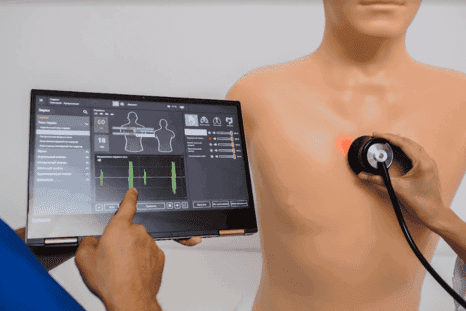Unleashing the Power of Auscultation Simulators Revolutionizing Neonatal Care
Auscultation, the act of listening to internal sounds of the body using a stethoscope, is a vital diagnostic tool in neonatal care. It allows healthcare professionals to assess the health of a newborn's heart, lungs, and other vital organs. However, mastering the skill of auscultation requires extensive training and experience. This is where auscultation simulators come into play. Auscultation simulators are advanced devices that replicate the sounds of a real infant's chest and heart, providing a realistic training experience for healthcare professionals. These simulators have revolutionized neonatal care by enhancing the accuracy and efficiency of auscultation training.
Importance of Auscultation in Neonatal Care
Auscultation is an essential component of neonatal care. It helps healthcare professionals identify abnormal sounds and diagnose various conditions early on, ensuring prompt intervention and treatment. For example, detecting a murmur in a newborn's heart can indicate a congenital heart defect that requires immediate attention. Similarly, abnormal lung sounds can be indicative of respiratory distress syndrome or other respiratory conditions. By accurately interpreting these sounds, healthcare professionals can make informed decisions about the care and treatment of newborns.
Benefits of Using Auscultation Simulators in Neonatal Care
The use of auscultation simulators in neonatal simulator offers numerous benefits. Firstly, simulators provide a safe and controlled environment for healthcare professionals to practice and refine their auscultation skills. This eliminates the risk of harm to real infants during training sessions. Secondly, simulators offer a wide range of realistic sounds, allowing healthcare professionals to familiarize themselves with different cardiac and respiratory conditions. This exposure to a variety of sounds enhances their ability to accurately identify abnormalities in real-life scenarios. Additionally, simulators provide instant feedback, allowing healthcare professionals to assess their performance and make improvements.
Features to Consider When Choosing an Auscultation Simulator
When selecting an auscultation simulator for neonatal care, several key features should be considered. Firstly, the simulator should accurately reproduce realistic chest and heart sounds. The quality and authenticity of these sounds are crucial for an effective training experience. Secondly, the simulator should have adjustable sound settings to simulate various conditions and levels of severity. This versatility ensures that healthcare professionals can practice diagnosing a wide range of cardiac and respiratory abnormalities. Additionally, the simulator should have a user-friendly interface and be compatible with other training tools and technologies to enhance the overall learning experience.
How to Use an Auscultation Simulator for Neonatal Care?
Using an auscultation simulator for neonatal care requires a systematic approach. Firstly, healthcare professionals should familiarize themselves with the simulator's user manual and instructions. This ensures proper handling and operation of the device. Secondly, they should identify the specific sounds they need to practice and set the simulator accordingly. For example, if they are focusing on identifying heart murmurs, they can select the appropriate setting that generates murmur sounds. Once the medical simulator is set, healthcare professionals can start practicing auscultation by placing the stethoscope on the designated areas of the simulator's chest. They should carefully listen to the sounds and try to identify any abnormalities. After each session, they can review their performance and seek feedback from experienced instructors or colleagues to further refine their skills.
Training Programs and Resources for Using Auscultation Simulators
To maximize the benefits of auscultation simulators, healthcare professionals can participate in training programs specifically designed for using these devices in neonatal care. These programs provide comprehensive instruction on auscultation techniques, interpretation of sounds, and the effective use of simulators. Additionally, there are online resources available, such as video tutorials and interactive simulations, that can supplement training programs. These resources allow healthcare professionals to practice at their own pace and reinforce their knowledge and skills. It is important for healthcare institutions to invest in ongoing training and education to ensure that their staff remains up-to-date with the latest advancements in auscultation simulation technology.
Limitations and Challenges of Auscultation Simulators in Neonatal Care
While auscultation simulators offer numerous advantages, they also have some limitations and challenges. Firstly, simulators may not fully replicate the complexity and variability of real-life patient scenarios. This can limit the realism of the training experience and the ability to accurately diagnose certain conditions. Additionally, the cost of acquiring and maintaining auscultation simulators can be a significant barrier for some healthcare institutions. Furthermore, the availability of trained instructors who can effectively teach the use of simulators may be limited. These challenges highlight the need for continuous research and development to improve the realism and accessibility of auscultation simulators.
Future Developments and Advancements in Auscultation Simulators for Neonatal Care
The field of auscultation simulation is continuously evolving, with ongoing advancements and developments. Researchers and manufacturers are constantly working to enhance the realism, functionality, and accessibility of auscultation simulators. Future developments may include the integration of artificial intelligence and machine learning algorithms to provide more accurate and personalized feedback during training. Additionally, advancements in sensor technology may allow for the detection of subtle changes in sounds, further improving the diagnostic capabilities of simulators. These advancements will undoubtedly contribute to the continued revolutionization of neonatal care and the effective training of healthcare professionals.
Conclusion
Auscultation simulators have revolutionized neonatal care by providing healthcare professionals with a realistic and safe environment to practice their auscultation skills. These simulators enhance the accuracy and efficiency of diagnosing cardiac and respiratory conditions in newborns, leading to improved patient outcomes. By considering the features of an auscultation simulator, healthcare professionals can choose the most suitable device for their training needs. Ongoing training programs and resources further enhance the effectiveness of auscultation simulation. While there are limitations and challenges, the future holds promising developments that will continue to improve the capabilities of auscultation simulators. By embracing these advancements, healthcare institutions can ensure high-quality neonatal care and the continuous professional development of their staff. Call us at www.mavericsolution.com to know more!



Comments
Post a Comment